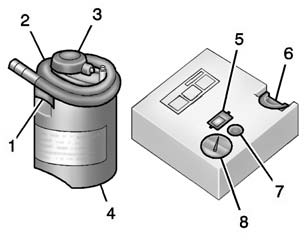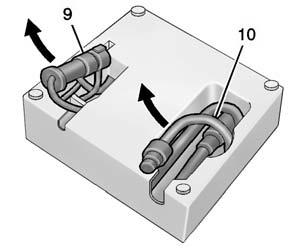Chevrolet Sonic Owner's Manual: Tire Sealant and Compressor Kit
Warning
Idling a vehicle in an enclosed area with poor ventilation is dangerous. Engine exhaust may enter the vehicle. Engine exhaust contains carbon monoxide (CO) which cannot be seen or smelled. It can cause unconsciousness and even death. Never run the engine in an enclosed area that has no fresh air ventilation. For more information, see Engine Exhaust.
Warning
Overinflating a tire could cause the tire to rupture and you or others could be injured. Be sure to read and follow the tire sealant and compressor kit instructions and inflate the tire to its recommended pressure. Do not exceed the recommended pressure.
Warning
Storing the tire sealant and compressor kit or other equipment in the passenger compartment of the vehicle could cause injury. In a sudden stop or collision, loose equipment could strike someone. Store the tire sealant and compressor kit in its original location.
If this vehicle has a tire sealant and compressor kit, there may not be a spare tire or tire changing equipment, and on some vehicles there may not be a place to store a tire.
The tire sealant and compressor can be used to temporarily seal punctures up to 6 mm (0.25 in) in the tread area of the tire. It can also be used to inflate an underinflated tire.
If the tire has been separated from the wheel, has damaged sidewalls, or has a large puncture, the tire is too severely damaged for the tire sealant and compressor kit to be effective. See Roadside Assistance Program.
Read and follow all of the tire sealant and compressor kit instructions.
The kit includes:

1. Sealant Canister Inlet Valve
2. Sealant/Air Hose
3. Base of Sealant Canister
4. Tire Sealant Canister
5. On/Off Button
6. Slot on Top of Compressor
7. Pressure Deflation Button
8. Pressure Gauge

9. Power Plug
10. Air Only Hose
- Tire Sealant
- Using the Tire Sealant and Compressor Kit to Temporarily Seal and Inflate a Punctured Tire
- Using the Tire Sealant and Compressor Kit without Sealant to Inflate a Tire (Not Punctured)
 If a Tire Goes Flat
If a Tire Goes Flat
It is unusual for a tire to blow out while driving, especially if the tires are
maintained properly. See Tires. If air goes out of a tire, it is much
more likely to leak out slowly. But if there i ...
 Tire Sealant
Tire Sealant
Read and follow the safe handling instructions on the label adhered to the tire
sealant canister (4).
Check the tire sealant expiration date on the tire sealant canister. The tire
sealant caniste ...
Other materials:
Rear Side Door Lock Cylinder Opening Cover Replacement
Rear Side Door Lock Cylinder Opening Cover Replacement
Callout
Component Name
1
Rear Side Door Lock Cylinder Opening Cover
Procedure
Remove the rear side door lock cylinder, Do Not
remove the outside door han ...
Air Conditioning Compressor Replacement (LDE, LUW, LWE)
Air Conditioning Compressor Replacement
Callout
Component Name
Preliminary Procedure
Recover the refrigerant. Refer to Refrigerant Recovery and Recharging.
Raise and support the vehicle. Refer to Lifting and Jacking the
...
Intake Manifold Assemble (1.6L LDE)
Install the 4 multiport fuel injector seals (6).
Install the multiport fuel injection fuel rail (4) and the fuel injectors (5)
to the intake manifold (7).
Caution: Refer to Fastener Caution.
Install the 2 multiport fuel injection fue ...
0.0091
